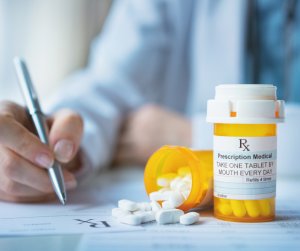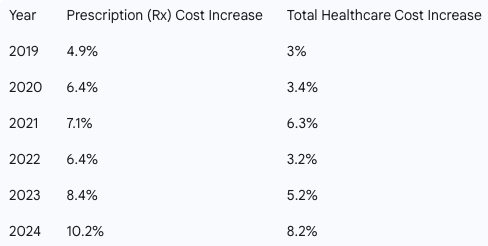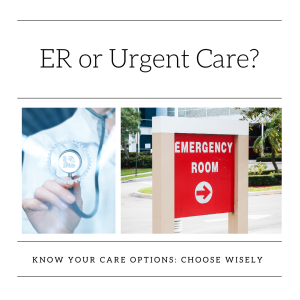
by admin | Oct 30, 2025 | Custom Content, Employee Benefits, Health Care Costs
 No doubt about it, prescriptions are expensive. While this may not be a big worry when you’re young and healthy, the costs can add up quickly if you’re diagnosed with a chronic condition or need an expensive drug. Whether you take medications regularly or for an occasional illness, it pays to know how to save money on prescriptions.
No doubt about it, prescriptions are expensive. While this may not be a big worry when you’re young and healthy, the costs can add up quickly if you’re diagnosed with a chronic condition or need an expensive drug. Whether you take medications regularly or for an occasional illness, it pays to know how to save money on prescriptions.
Did You Know?
Drug costs are a primary driver of rising healthcare expenses for both employers and employees. Prescription drug spending is consistently growing at a faster rate than overall healthcare costs, with a steady increase of 6.8%. As the fastest-growing part of benefits plans, these costs will continue to climb with new pharmaceutical innovations.
For years in the U.S., cost has been a significant obstacle to sticking with medications with up to 3 in 10 people reporting that they do not take their medications as prescribed.
The Rising Cost of Prescriptions
Historically, prescription drug costs have outpaced total healthcare costs. The following chart highlights this trend from 2019 to 2024. 
Prescription drug costs can put a strain on your budget, but with a little research and the right questions, you can reduce expenses without sacrificing your health.
Here are expert-backed strategies to help you save on your medications:
-
-
- Ask About a Generic Drug – Get the same quality and active ingredient as you’d find in a brand name, for less money.
- Save Money with a Pill Splitter – If your prescription comes in a higher dose that can be safely split, you get 2 doses for the price of 1.
- Consider a Combo Pill – Combining two drugs into one pill can help you avoid paying separate copays or coinsurance. Ask if a combo pill is an option for you.
- Buy in Bulk – Opt for a mail-order pharmacy to get a 90-day supply of your meds instead or a 30-day supply. This can often reduce your copay and overall cost.
- Make a List and Check it Twice – Check the list of preferred medications (a.k.a. “the formulary”), which tend to cost less.
- Find Out if You Still Need That Medication – If you’ve been taking the same medication for years, it’s worth checking in with your doctor to see if you still need it. Or if you’ve made a lifestyle change, it may reduce your need for certain medications. It never hurts to ask your doctor.
-
-
-
-
-
The medicines prescribed by your doctor are essential to your good health. With some savvy shopping, you can use the money you save on the things you enjoy!

by admin | Sep 15, 2025 | Health Care Costs, Health Insurance
 PwC’s latest annual analysis forecasts that group health insurance costs will increase by 8.5% in 2026—the third straight year at this elevated trend. This sustained rise means health care expenses are now similar to those seen 15 years ago, after a brief dip post-pandemic.
PwC’s latest annual analysis forecasts that group health insurance costs will increase by 8.5% in 2026—the third straight year at this elevated trend. This sustained rise means health care expenses are now similar to those seen 15 years ago, after a brief dip post-pandemic.
Researchers gathered data from actuaries at 24 major U.S. health plans, covering more than 125 million employer-sponsored members and 12 million ACA marketplace members. The “medical cost trend” refers to the expected annual increase in health plan spending.
Key factors driving this growth include:
Hospital expenses: Wages for healthcare workers, supply prices, and rising operational costs all contribute. Many hospitals are intensifying revenue cycle management activities, increasing inpatient admissions, and pushing more costs onto commercial health plans.
Prescription drugs: Spending is up, notably driven by new therapeutics such as GLP-1 medications for chronic illnesses and rare genetic conditions. Drug spending soared by $50billion in 2024, with GLP-1s poised for further approvals.
Behavioral health services: Inpatient behavioral health claims jumped nearly 80%, and outpatient claims rose almost 40%. One in three actuarial leaders cited behavioral health as a top driver of rising costs, projecting a 10%-20% trend for this segment in 2026.
Offsetting factors, though limited in impact, include:
Biosimilars: For the third straight year, biosimilar drugs are cited as a leading cost deflator. Their adoption continues to grow and may help moderate spending.
Care management: Health plans are finding success with cost management strategies, such as utilization management, pharmacy oversight, and AI-powered claims review—tools that could dampen the medical cost trend.
The report also highlights upcoming federal policy changes, like the One Big Beautiful Bill (OBBB) Act, which may bring more cost pressure through adjustments to Medicaid eligibility, lapsing ACA subsidies, and proposed tariffs on imported pharmaceuticals.
Ultimately, industry analysts anticipate medical costs will keep climbing into 2026 and likely beyond, forcing employers to pursue affordability strategies while managing the growing burden of health coverage costs.

by admin | Jan 9, 2025 | Employee Benefits, Health Care Costs
 Healthcare costs are projected to rise significantly in 2025. To mitigate these increases, consider these tips:
Healthcare costs are projected to rise significantly in 2025. To mitigate these increases, consider these tips:
- Know Your Plan: Take time to review what your health plan covers—and what it doesn’t—to avoid unexpected costs. Understand your health plan’s coverage, including deductibles, co-pays, and out-of-pocket maximums.
- Utilize In-Network Providers: Receiving care from out-of-network providers can dramatically increase costs. Check your plan details to confirm that your provider is in-network before scheduling any appointments.
- Budget Wisely: Plan for potential healthcare expenses throughout the year.
- Ask Questions: Don’t hesitate to ask your doctor questions during visits. If you need care, inquire about alternative treatments or services that are both effective and more affordable.
- Get Annual Check-Ups and Screenings: The best way to ward off many illnesses is to not them sneak up on you.
- Take Care of Your Health: A simple way to save money on healthcare is to stay healthy. By staying at a healthy weight, exercising regularly, and not smoking lowers your risk for health problems.
- Consider using a Health Savings Account (HSA) or a Flexible Spending Account (FSA): Many employers offer an HSA or FSA. These are savings accounts that allow you to set aside pre-tax dollars for healthcare expenses. This can help save you several hundred dollars per year.
- Telehealth: Utilize telehealth services when appropriate to reduce urgent care or doctor’s visits costs.
Staying informed about your health care benefits—including the fine print—can help you save money. By taking these steps, you can help to manage your healthcare costs and protect your financial well-being.

by admin | Dec 16, 2024 | Health Care Costs
 Health care expenses are expected to rise significantly in 2025, with projections indicating a 7%-8% increase. This aligns with similar trends in 2024, showcasing the cumulative impact of ongoing cost growth. Below are the primary drivers of these increases:
Health care expenses are expected to rise significantly in 2025, with projections indicating a 7%-8% increase. This aligns with similar trends in 2024, showcasing the cumulative impact of ongoing cost growth. Below are the primary drivers of these increases:
- GLP-1 Medications: Glucagon-like peptide-1 drugs typically require long-term use to deliver intended health benefits. Currently, 6% of Americans use these medications, with the percentage potentially rising to 9% by 2030.
- Pharmacy Costs: Rising costs in general pharmacy are fueled by price hikes for existing drugs, along with innovations like cell and gene therapies, biologics, and biosimilars.
- Health Care Workforce Costs: Increased spending on wages and staffing in the health care sector often translates into higher costs for employers and patients.
- Chronic Conditions: About 90% of U.S. health care spending is dedicated to managing mental and chronic health conditions, including heart disease, cancer, diabetes, and obesity.
- Aging Population: The number of Americans aged 65 and older continues to rise, with over 55 million aged 55 or older currently. By 2040, nearly 80 million are expected to be in this age group.
Although these rising costs are inevitable, informed employers can proactively address these challenges. Reach out to us for additional insights and resources.

by admin | Nov 26, 2024 | Custom Content, Health Care Costs
 All too often, illness or injury appears out of the blue: You wake up in the middle of the night with intense abdominal pain. Or your baby spikes a high fever on the weekend. These situations are stressful and it’s hard to think when you’re under stress. But you need to decide where to go to get medical care for yourself or a loved one. Understanding the levels of acute medical care before you need it can help you focus and get the appropriate help quickly.
All too often, illness or injury appears out of the blue: You wake up in the middle of the night with intense abdominal pain. Or your baby spikes a high fever on the weekend. These situations are stressful and it’s hard to think when you’re under stress. But you need to decide where to go to get medical care for yourself or a loved one. Understanding the levels of acute medical care before you need it can help you focus and get the appropriate help quickly.
Urgent care centers and emergency rooms are both great options for times when you are unable to see your primary care physician (PCP). The reasons for choosing these facilities can be because the injury or sickness has occurred outside normal office hours for your doctor or that you are out of town when an emergency hits. As you know, the first choice for non-life or limb-threatening conditions should be your regular doctor—they will have your medical history on file and your medication list at the ready. When this is not an option, you will need to make the choice on what level of care you need.
Urgent Care Centers
Urgent care centers fill the gap between when you are sick or minorly injured but cannot see your PCP and when you can’t wait for an appointment. Most urgent care locations are staffed by doctors or physician’s assistants. These centers can get you in and out quickly and some even take appointments. Since you will not see your PCP at these clinics, it’s always best to bring a copy of all the medications and dosages of meds you take. If you have a special condition, like epilepsy, make sure you disclose that to the urgent care provider you see. Most have access to x-ray machines and basic diagnostic tests. The typical range of costs for care at these centers is between $175-$200.
Here are some conditions that typically can be seen at urgent care centers:
- Fevers, flu or cold symptoms
- Ear infections
- Bronchitis
- Cuts and bleeding that may require stitches
- Urinary tract infections
- Vomiting or diarrhea
- Minor back pain
Emergency Room Care
Hospital emergency rooms provide care for life and limb-threatening situations ranging from heart attack and stroke to car accident injuries. Staffed by physicians, nurses, and specialists, emergency rooms have access to highly knowledgeable and diverse medical teams. In emergency rooms, care is given to the most serious injury/illness first—not on a first-come, first-served basis. Because of this, wait times in emergency rooms are widely varied and may be into a several hours-long wait. Again, it is wise to bring a list of any medications, both prescribed and over-the-counter, with you when seeking care since the ER will not have this information from your PCP. The average cost of an emergency room visit costs $2,700 according to UnitedHealthcare.
Symptoms that are best evaluated in an emergency room include:
- Chest pain or difficulty breathing
- Weakness/numbness on one side
- Slurred speech
- Fainting/change in mental state
- Serious burns
- Head injury
- Concussion/confusion
- Broken bones and dislocated joints
- Seizures
- Severe cuts that may require stitches
- Vaginal bleeding with pregnancy
When deciding between urgent care and the emergency room, start by assessing your symptoms. Ask yourself, “Is this condition life-threatening or likely to cause permanent damage?” If the answer is “yes,” head to the nearest ER. If it’s “no,” take your non-life-threatening injury to an urgent care center for stitches or treatment. Choosing the right care option saves you both time and money!

 No doubt about it, prescriptions are expensive. While this may not be a big worry when you’re young and healthy, the costs can add up quickly if you’re diagnosed with a chronic condition or need an expensive drug. Whether you take medications regularly or for an occasional illness, it pays to know how to save money on prescriptions.
No doubt about it, prescriptions are expensive. While this may not be a big worry when you’re young and healthy, the costs can add up quickly if you’re diagnosed with a chronic condition or need an expensive drug. Whether you take medications regularly or for an occasional illness, it pays to know how to save money on prescriptions.





